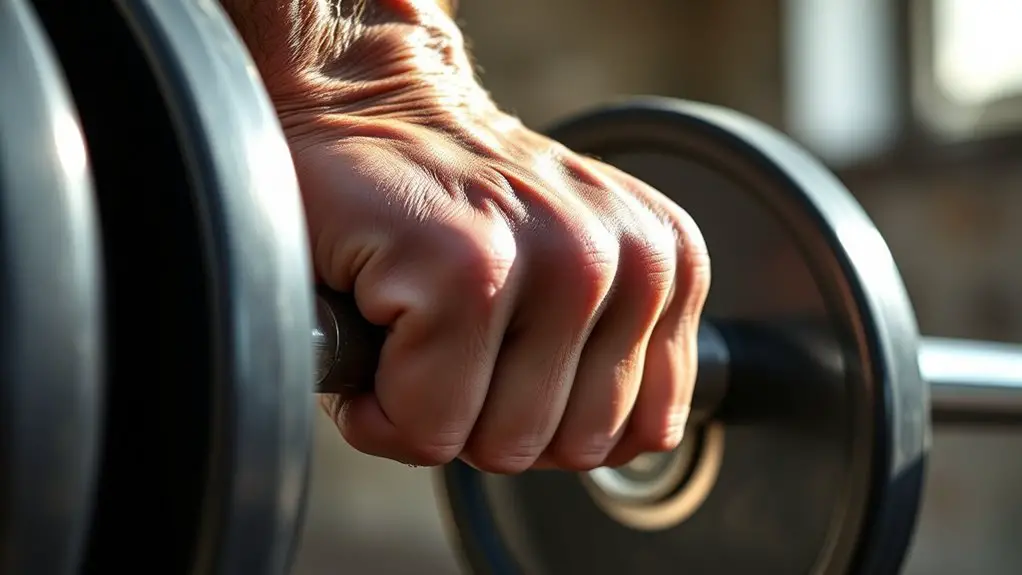Fast bar speed is essential in weightlifting because it boosts power generation and enhances muscle activation. When you move the bar quickly, you engage muscle fibers more effectively, leading to greater strength gains. Faster lifts also promote proper movement mechanics, reducing the risk of injury and strain on your joints. By focusing on speed, you can improve your overall lifting performance. Keep exploring to discover techniques that can take your bar speed to the next level.
The Science Behind Bar Speed and Power Generation
When you're lifting weights, understanding the science behind bar speed can make all the difference in your performance. Bar acceleration directly impacts how much kinetic energy you generate, which is essential for maximizing your lifts. The faster you move the bar, the more power you release, translating to better results. By focusing on a quick, explosive lift, you can engage your muscles more effectively, allowing you to break through plateaus and achieve new personal records.
Moreover, optimizing bar speed isn't just about lifting heavier weights; it's about mastering your technique and harnessing your strength. When you align your body mechanics with the principles of bar acceleration, you create a synergy that enhances your overall training experience. Remember, it's not merely about the weight on the bar; it's how you lift it that counts. Embrace the freedom of movement, and let your understanding of bar speed propel you toward your goals.
Muscle Activation and Its Relationship With Speed
While bar speed is essential for performance, muscle activation plays an equally important role in maximizing your lifts. When you focus on explosive strength, you're not just moving the bar quickly; you're engaging your muscle fibers to their fullest potential. This activation is vital for generating the force needed to propel the weight upward effectively.
The faster you can activate those muscle fibers, the more power you'll produce, leading to better performance. Think of it this way: without activating your muscles properly, even the fastest bar speed won't translate into gains.
Incorporating explosive movements into your training can enhance muscle activation, helping you build the strength necessary for heavier lifts. Olympic lifts are a prime example of exercises that promote this explosive strength. So, as you work on your bar speed, remember to prioritize the quality of muscle engagement. That combination will set you free to reach new heights in your weightlifting journey.
The Role of Fast Bar Speed in Injury Prevention
Fast bar speed can greatly reduce the risk of injury, as it promotes proper movement mechanics and efficient force application. When you lift with speed, you enhance your body's natural ability to stabilize and control the load. This helps you avoid common injury risks associated with slower, less controlled movements. Implementing strengthening exercises that focus on form and control can further support your knee health and overall stability.
| Fast Bar Speed Benefits | Injury Risks Reduced |
|---|---|
| Improved coordination | Strain on muscles and joints |
| Enhanced stability | Overuse injuries |
| Efficient recovery protocols | Incorrect movement patterns |
Incorporating fast bar speed into your training can empower you to lift safely and effectively. When you move with purpose, you not only maximize your performance but also minimize wear and tear on your body. So, embrace speed in your lifts, and watch how it transforms your approach to weightlifting while keeping you free from injury worries.
Techniques to Improve Your Bar Speed
To boost your bar speed, focus on technique and specific training methods that enhance explosiveness. Start by incorporating speed drills into your routine. These can include exercises like jump squats and power cleans that train your body to generate force quickly. Emphasizing explosive movements helps you develop the fast-twitch muscle fibers essential for lifting heavier weights faster.
Additionally, refine your technique during lifts. Confirm your grip, stance, and body alignment are ideal to maximize efficiency. Practicing with lighter weights allows you to maintain speed while honing your form.
Don't forget about plyometrics; they're fantastic for building explosiveness. Box jumps and depth jumps can help you develop the power necessary to drive the bar up swiftly. Remember, the goal is to feel free and fluid in your movements, so focus on what makes you feel powerful and fast. Embrace these techniques, and you'll see improvements in your bar speed. Furthermore, focusing on functional strength is crucial for enhancing your explosive power and overall performance.
Incorporating Speed Training Into Your Routine
Incorporating speed training into your routine is a game-changer for improving your overall performance in weightlifting. You'll want to focus on speed drills that enhance your explosive movements, allowing you to lift heavier and more efficiently. Start by integrating exercises like power cleans or snatch pulls, which demand rapid acceleration.
Consider dedicating a portion of your workouts to these explosive movements, ensuring you're not just lifting but doing so with speed and precision. Even simple drills, like plyometrics or sprinting, can greatly boost your bar speed and overall athleticism. Additionally, plyometric exercises can significantly improve your power and coordination, further enhancing your lifting performance.
Frequently Asked Questions
How Does Bar Speed Affect Overall Weightlifting Performance?
Did you know that lifters can achieve up to a 10% increase in performance metrics with just a 5% boost in bar acceleration? When you focus on bar speed, you're not just lifting weights; you're revealing your potential. Faster bar speeds can lead to more explosive movements, enhancing your overall performance. So, if you want that freedom to lift heavier and move better, prioritize improving your bar speed and watch your results soar!
Can Slower Bar Speeds Lead to Muscle Imbalances?
Slower bar speeds can indeed lead to muscle imbalances. When you lift slowly, you might not recruit all the necessary muscle fibers effectively, which can hinder overall muscle development. This uneven recruitment could increase your risk of injury, as some muscles become overworked while others lag behind. To maintain freedom in your movements and prevent complications, it is crucial to focus on balanced training that promotes consistent bar speed and muscle engagement.
What Equipment Aids in Measuring Bar Speed?
You might think measuring bar speed's complicated, but it's actually quite straightforward! There are several measurement devices available, like linear position transducers, accelerometers, and even smartphone apps that can track your bar speed in real-time. These tools help you monitor your performance, making it easier to adjust your technique and maximize your gains. With the right equipment, you'll find freedom in your training, allowing you to push your limits effectively.
Is Bar Speed More Important Than Lifting Technique?
You might wonder if bar speed's more important than lifting technique. While both are essential, neglecting technique can lead to injury and hinder your progress. Fast bar speed can enhance performance, but if your form's compromised, you're not maximizing your potential. Ultimately, it's about finding a balance. Focus on mastering your lifting technique first, then work on increasing bar speed to elevate your lifts while ensuring safety and efficiency in your training.
How Do Different Lifts Require Varying Bar Speeds?
Different lifts do require varying bar speeds, and understanding this can really enhance your training. For instance, Olympic lifts like the clean and jerk demand a faster bar speed to generate momentum, while powerlifting moves like the squat might focus more on controlled strength. By recognizing these lift variations, you can tailor your approach, ensuring you're not just lifting, but lifting effectively and freely, maximizing your performance with each rep.




